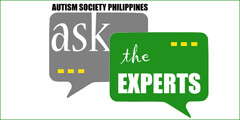By: Dang U. Koe, ASP Chair Emeritus
 |
| hands |
How did Gio react to his father’s death?”
That was one of the most frequently-asked questions during the wake of my husband who passed away a little over a month ago.
My 16-year old autistic son Gio is challenged with his language and cognitive skills. So I am not really sure with my answer to the above-mentioned question. But fortunately, he was very calm all throughout the “unfamiliar” funeral situation. He was patiently sitting and waiting for at least five hours each time he was in the funeral parlor during the three-night wake. Used to sleeping by 8 p.m., he slept with nary a complaint on one of the wooden benches while waiting for his ride home. During the interment of his father’s ashes, Gio was very compliant with instructions given him.
Things may be different though for others in the autism spectrum disorder during these very trying moments. Families may need to prepare for it.
The website of UK’s The National Autistic Society (NAS) has a section which covers the difficult issue of helping a child with autism to cope with the death of someone known to them. According to said website, NAS is UK’s largest provider of specialist autism services. Their trained staff and volunteers provide a lifeline for 100,000 people every year, offering support with day-to-day living, social skills, education and employment.
Angels Talk sought the permission of NAS to share its website’s section on “Death, Bereavement and Autism Spectrum Disorders (ASDs).”
Death and bereavement are subjects we do not not find easy to discuss. This natural reluctance means that we avoid discussing death until it is too late, especially with someone who has ASD.
Clearly every child is different, and their level of understanding will differ, too. Therefore you may have to make some adjustments for your individual child, and adults with ASD as well.
PREPARE YOUR CHILD AS MUCH AS POSSIBLE.
As with most life experiences, a child with an ASD will understand and adjust better if they are involved in the situation and prepared for dealing with it as much as possible. If someone in the family is ill, it is better to explain what is occurring and why grandma, for example, keeps going to the doctors or spending time in hospital. This is because unexplained occasions and the unknown often, scare people with ASD, producing anxiety and challenging behavior. As a family you will need to decide how much detail will be appropriate, but do remember to explain any possible change in the person’s appearance.
KEEP ROUTINE CHANGES TO A MINIMUM
It is only natural to be concerned that you will make your child anxious by telling them about an illness. That worry is understandable in such a situation but you may nevertheless upset and confuse the child by not telling them. By providing your child with an explanation, and changing as little as possible, that anxiety will be kept to a minimum.
It may help your child to understand the progression of the person’s illness by charting on a timeline or calendar the various appointments that the person will attend, including any prolonged stays in hospital. Alongside these, you can also position any significant dates for the child; for example, their birthday, school play or first day at college. You could also add any routine changes, such as who will pick them up from school. This is particularly important if that role is normally fulfilled by the family member who is ill. This will help the child with ASD to see the situation in a more general context within their life. Also, as change is difficult for any person with an ASD, this will remind your child about those things in their life which will remain the same, such as attending school every day.
USE VISUAL SUPPORTS WHEN APPROPRIATE
If the person’s illness becomes more serious, you may feel that you need to prepare the child for this individual’s possible death. Your explanation of what death is will be determined by your own beliefs and values. However, Allison (2001) suggests explaining death within a life cycle, possibly using insects, plants or animals to demonstrate this. This biological approach is practical, clear, and could be presented visually. Many individuals on the autism spectrum respond well to visual descriptions.
In one case, a school took this principle a stage further in order to explain.
Explaining death to children with autism death to a five-year-old child with an ASD whose father had terminal cancer. They got a dead chicken from a local farm and named it Charlie. Charlie was shown to the child, who commented that “Charlie not moving” (Ulliana 1998). They explained that Charlie would not move again as he had died. They then put Charlie in a box, which they referred to as a coffin, and buried him with a cross placed above the grave (presumably this reflected the family’s own beliefs). They photographed this process and compiled these into a book which they entitled ‘Brett says Goodbye to Charlie Chicken’. This method was then used with Brett’s father, as they photographed Brett with him, in hospital, before his death and took pictures of his empty bed after he had died. Again, these photographs were placed in a book called ‘Brett says Goodbye to Daddy.’ This book was then used to talk regularly to Brett about his father in the weeks and months after his death. Although this preparation might seem morbid, the school clearly appreciated this child’s need for visual supports in order for him to understand death, and where his father had gone.
USE CLEAR SIMPLE LANGUAGE
Remember to be careful about the language you use, especially if your child is literal in their understanding and interpretation. For example, if you describe death as “like going to sleep.” you may make the individual terrified of going to sleep at night. Something simple such as “sometimes people’s bodies become worn out” may be appropriate. If they want to know what this means, or how it will affect their lives, you could say that they “will not see grandma again”.
You will also need to explain any religious practices that your family observes at the time of death. This might include visiting in advance the place where any ceremony will be performed, speaking to the person leading the observance, and introducing the child to any other unknown practice. It may be a good idea to ask an appropriate relative to care for the individual during the funeral. This will help to ease the pressure on the immediate family and will also provide a reliable person for your child during this difficult occasion.
There is a series of books available called “Books Beyond Words’’ which explains burial, cremation and bereavement counseling. These books are not specifically written for people with ASD, but they use only pictures and are therefore ideal for use with individuals who have autism.
ESTABLISH RITUALS
Whether your family has specific religious beliefs or not, it may help to establish a particular ritual within the family when someone dies, whether this is a pet, family member, friend or even a personality on TV whom the child liked. This will give your child a particular routine to follow and will hopefully lessen any inappropriate responses to the announcement of a death, which may cause further distress to other members of the family. This ritual might involve the simple lighting of a candle, while everyone thinks about the person or animal being remembered. By “preparing people with autism for the losses which can occur, they may become more able to cope with major bereavements.” (Allison 2001)
ASSURE YOUR CHILD
A sudden death may cause more extreme forms of upset and confusion. But this reaction is natural and will probably be experienced by everyone within the family. When explaining why that person died, you may need to reassure the child with an ASD that this will not happen to them. You may like to set a boundary on age, for example: usually only people over 70 years of age die, and it is rare for children or people younger than that to die. However, if you do use this, please think very carefully about the likelihood of your child experiencing a younger person’s death.
UNFAMILIAR DISPLAYS OF GRIEF
Howlin (1997) describes how the “person with autism may seem apparently unconcerned, even by the death of someone very close,... [they may focus on] seemingly callous issues, such as how much they may have been left in the will.” She then outlines one particular adult’s reaction to her father’s death, describing how she “began to embark on bizarre monologues about punishment and pain, murder and the police”, though her father’s death had not involved the police in any way.
These behavioral changes may not coincide with the death of a relative or friend, but may occur perhaps three months, six months, or a year afterwards. This will need to be recognized so these behaviors are appropriately understood and supported. You may notice a reoccurrence of these or other behaviors at significant dates after the person’s death; for example, at an anniversary, Christmas or birthdays.
STAGES OF BEREAVEMENT
There are recognized approximate stages of bereavement (Allison 2001):
• Shock, numbness, denial
• Despair, turmoil and acute grieving, including: anger, guilt anxiety, fear, panic, depression, pain, appetite disturbance, breathlessness, illness, more than usual need for sleep, sleeplessness, hyperactivity, nightmares, regression, loss of skills
• Recovery, including acceptance, resolution of grief, when the bereaved can think of the deceased without pain or anger and can recall the times they had together in a positive way.
Please be aware of these stages: they may merge together, and not everyone will experience all of them. Your child may have all of these feelings, and others too. For example, they may experience confusion over why they do not see the person any more, or anxiety about why members of the family seem to be acting differently. You may like to use a Social Story to explain how people become upset and cry when someone has died, and perhaps that it is okay that they have/have not cried.
MEMORY BOOK
When it is appropriate, you might also consider making a ‘Memory Book’ (Allison 2001). This could be a book or box which is used as a record and reminder of the individual or pet who has died; it could also be used more generally to highlight significant moments in your child’s life. They might choose mementos which show “...happy incidents in their lives, family holidays, previous homes, photographs of family members and pets...” This record can then be used to demonstrate the role that the deceased individual had in the life to the child with ASD. This role will also be seen in a more general context of life progression, as the child can see previous homes, pets and friends which they no longer encounter.



 Posted in:
Posted in: 

0 comments:
Post a Comment